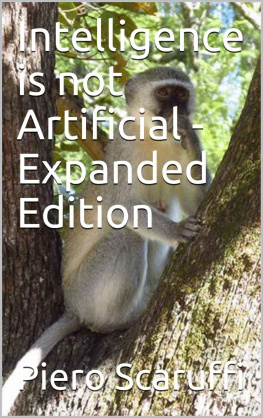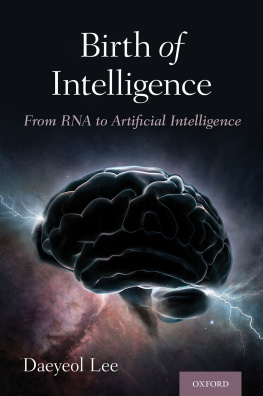PANDORAS BRAIN
CALUM retired in 2012 to focus on writing after a 30-year career in business, in which he was a marketer, a strategy consultant and a CEO. He maintains his interest in business by serving as chairman and coach for growing companies.
He is co-author of The Internet Startup Bible , a business best-seller published by Random House in 2000. He is a regular speaker on artificial intelligence and related technologies and runs a blog on the subject at www.pandoras-brain.com.
He lives in London and Sussex with his partner, a director of a design school, and their daughter. He studied philosophy at Oxford University, where he discovered that the science fiction he had been reading since early boyhood is actually philosophy in fancy dress.
PANDORAS BRAIN
CALUM CHACE
Three Cs Publishing
For Julia and Lauren
PANDORAS BRAIN
A Three Cs book.
ISBN: 978-0-9932116-0-7
First Published in 2015 by Three Cs.
Copyright Calum Chace 2015
Cover and interior design Rachel Lawston at Lawston Design, www.lawstondesign.com
Photography iStockphoto.com/PeopleImages
All rights reserved
The right of Calum Chace to be identified as the author of this work has been asserted by him in accordance with the Copyright, Design and Patents Act 1988.
If a superior alien civilization sent us a text message saying, Well arrive in a few decades, would we just reply, OK, call us when you get here well leave the lights on? Probably not, but this is more or less what is happening with AI. Although we are facing potentially the best or worst thing ever to happen to humanity, little serious research is devoted to these issues... All of us not only scientists, industrialists and generals should ask ourselves what can we do now to improve the chances of reaping the benefits and avoiding the risks. Stephen Hawking, April 2014
SELECTED REVIEWS FOR PANDORAS BRAIN
I love the concepts in this book! Peter James, author of the best-selling Roy Grace series
Pandoras Brain is a captivating tale of developments in artificial intelligence that could, conceivably, be just around the corner. The imminent possibility of these breakthroughs causes characters in the book to re-evaluate many of their cherished beliefs, and will lead most readers to several OMG realisations about their own philosophies of life. Apple carts that are upended in the processes are unlikely ever to be righted again. Once the ideas have escaped from the pages of this Pandoras box of a book, theres no going back to a state of innocence.
Mainly set in the present day, the plot unfolds in an environment that seems reassuringly familiar, but which is overshadowed by a combination of both menace and promise. Carefully crafted, and absorbing from its very start, the book held my rapt attention throughout a series of surprise twists, as various personalities react in different ways to a growing awareness of that menace and promise. David Wood, Chairman of the London Futurist Group
Awesome! Count me as a fan. Brad Feld,co-founder of the Foundry Group and Techstars
Its hard not to write in clichs about Calum Chaces premiere novel: a page-turner, a hi-tech thriller, action-packed, and thought-provoking all come to mind. But in a world where most people arent thinking past their next text message and what theyre having for lunch, Chace has crafted a novel that provides a credible look at where the human race could be tomorrow and the next day. Its the future of sci-fi: a totally realistic, totally readable book that challenges you as it entertains. So, if you like to read and if you like to think, I have one piece of adviceopen Pandoras Brain .Jeff Pinsker, Vice President, Scholastic
Pandoras Brain is a tour de force that neatly explains the key concepts behind the likely future of artificial intelligence in the context of a thriller novel. Ambitious and well executed, it will appeal to a broad range of readers.
In the same way that Suarezs Daemon and Naams Nexus leaped onto the scene, redefining what it meant to write about technology, Pandoras Brain will do the same for artificial intelligence.
Mind uploading? Check. Human equivalent AI? Check. Hard takeoff singularity? Check. Strap in, this is one heck of a ride. William Hertling, author of the Avogadro series of novels
I was eagerly anticipating a fiction adventure book on precisely this topic! Very well done, Calum Chace. A timely, suspenseful, and balanced portrayal of AI and the most important decisions humanity will make in the near future. Hank Pellissier, producer of the Transhuman Visions conferences
ONE
The warriors tied their war canoes to the trees at the edge of the Usumacinta River, and waited. The canoes were long, each carrying up to 50 men. They came from several different cities: the first to arrive were from Palenque, but over the next couple of hours they were followed by boats from Bonampak, Piedras Negras and Yaxchilan cities linked by the river. As each group arrived they were greeted by those already waiting with grins and raised fists, but no-one said a word. This was the biggest fighting force deployed in the Maya rainforest for generations, and they wanted to retain the advantage of surprise for as long as possible
The air was heavy and humid as they waited for the drums which would let them know that their other allies from the cities of Calakmul and Caracol had also arrived. Mighty Pakal, the ruler of Palenque, had spent months negotiating this alliance with the other chiefs, and today was the day when the alliance would be tested, and sealed in blood.
The city of Palenque was rising. Its brightly painted stone-and-stucco buildings were now among the most impressive in the whole of the Maya highlands. Its population was numerous, well-fed, and united. Its rituals were elaborate affairs, well supplied with animal sacrifices, although sparing in their use of human sacrifice. Its warriors were powerful: superbly trained and experienced in battle. If they were successful in todays combat, the swaggering pre-eminence of Tikal would be smashed.
Other cities had risen to challenge Tikal in the past, and so far they had all been crushed by the fierce hammer of Tikals elite Hawk warrior squad. The fighting prowess and ruthlessness of the Hawks was legendary, and was used to frighten and discipline unruly children throughout the jungle highlands.
But no previous challenge had been launched by Palenques great leader, Lord Pakal. Pakal was a phenomenon, combining remarkable physical strength with outstanding skills in strategy and negotiation. He devised plans and constructed alliances that no-one else dreamed of, yet when he explained them they seemed the obvious thing to do. And his patience during the long weeks of negotiations which brought those plans to fruition was superhuman. No citys negotiators left Palenque without agreeing to Lord Pakals proposals.
As a result his people, and most importantly his warrior clan, considered him infallible. They would follow him confidently into the flames of the underworld, certain that Lord Pakal would lead them to safety. And his elite fighting group the Jaguars, led by Mat-Balam, was building a reputation to rival that of Tikals Hawks.
The Jaguars squatted, checking their equipment while they waited. Most of them wore short cotton protective jackets packed with rock salt, and tight bindings of leather or cloth on their forearms and legs. A few pulled on elbow, wrist and knee protectors made of copper alloys, worked to fit comfortably and to glance off sword and knife blows.
Many had daubed patterns on their faces with azure blue paint. They ran calloused fingers along the sharp blades of their weapons to check they had not been nicked or blunted during the two-day river journey.
They felt the weight of their macuahuitl clubs wooden truncheons embedded with vicious slivers of sharp obsidian. They tested the edges of their swords, short stabbing spears, and wooden axes, hardened with fire and finished with flint or obsidian blades. They checked their projectile weapons too: spears, sometimes set in atlatl spear-throwers. Finally they poked and prodded their shields, which were either long and flexible if made of hide, or smaller, rigid and round if made of wood.
Next page










